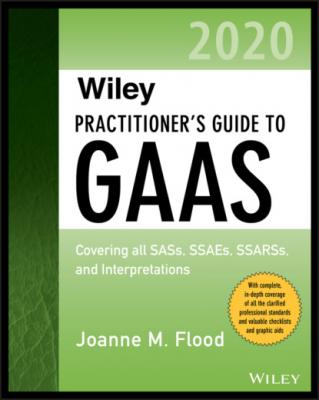Wiley Practitioner's Guide to GAAS 2020. Joanne M. Flood
Читать онлайн.| Название | Wiley Practitioner's Guide to GAAS 2020 |
|---|---|
| Автор произведения | Joanne M. Flood |
| Жанр | Бухучет, налогообложение, аудит |
| Серия | |
| Издательство | Бухучет, налогообложение, аудит |
| Год выпуска | 0 |
| isbn | 9781119596035 |
Comparison of the account balance at year-end with the balance at the interim date to identify unusual amounts or relationships.
Investigation of unusual amounts or relationships.
Application of other analytical procedures to the year-end balance.
Naturally, as with any rule of thumb, the auditor should be aware that in specific circumstances, factors may increase audit risk, and the principal substantive tests will have to be applied at year-end.
Designing Audit Procedures
There is an almost infinite variety of approaches that an auditor can use in practice to achieve the objectives of AU-C 330. The following chart shows some examples of further audit procedures that may be performed to meet certain audit objectives.
| Illustrative assertions about account balances | Examples of substantive procedures |
| Existence or Occurrence | |
| Inventories included in the balance sheet physically exist. | Observing physical inventory counts. Obtaining confirmation of inventories at locations outside the entity. Testing of inventory transactions between a preliminary physical inventory date and the balance sheet date. |
| Inventories represent items held for sale or use in the normal course of business. | Reviewing perpetual inventory records, production records, and purchasing records for indication of current activity. Comparing inventories with a current sales catalog and subsequent sales and delivery reports. Using the work of specialists to corroborate the nature of specialized products. |
| Completeness | |
| Inventory quantities include all products, materials, and supplies on hand. | Observing physical inventory counts. Analytically comparing the relationship of inventory balances to recent purchasing, production, and sales activities. Testing shipping and receiving cutoff procedures. Obtaining confirmation of inventories at locations outside the entity. |
| Inventory quantities include all products, materials, and supplies owned by the entity that are in transit or stored at outside locations. | Analytically comparing the relationship of inventory balances to recent purchasing, production, and sales activities. Testing shipping and receiving cutoff procedures. |
| Inventory listings are accurately compiled and the totals are properly included in the inventory accounts. | Tracing test counts recorded during the physical inventory observation to the inventory listing. Accounting for all inventory tags and count sheets used in recording the physical inventory counts. Testing the clerical accuracy of inventory listing. Reconciling physical counts with perpetual records and general ledger balances and investigating significant fluctuations. |
| Rights and Obligations | |
| The entity has legal title or similar rights of ownership to the inventories. | Observing physical inventory counts. Obtaining confirmation of inventories at locations outside the entity. Examining paid vendors’ invoices, consignment agreements, and contracts. |
| Inventories exclude items billed to customers or owned by others. | Examining paid vendors’ invoices, consignment agreements, and contracts. Testing shipping and receiving cutoff procedures. |
| Valuation or Allocation | |
| Inventories are properly stated at cost (except when market value is lower). | Examining paid vendors’ invoices. Reviewing direct labor rates. Testing the computation of standard overhead rates. Examining analyses of purchasing and manufacturing standard cost variances. |
| Existence or Occurrence | |
| Slow-moving, excess, defective, and obsolete items included in inventories are properly identified. | Examining an analysis of inventory turnover. Reviewing industry experience and trends. Analytically comparing the relationship of inventory balances to anticipated sales volume. Touring the plant. Inquiring of production and sales personnel concerning possible excess of obsolete inventory items. |
| Inventories are reduced, when appropriate, to replacement cost or net realizable value. | Obtaining current market value quotations. Reviewing current production costs. Examining sales after year-end and open purchase order commitments. |
| Presentation and Disclosure | |
| Inventories are properly classified in the balance sheet as current assets. | Reviewing drafts of the financial statements. |
| The major categories of inventories and their bases of valuation are adequately disclosed in the financial statements. | Reviewing drafts of the financial statements. Comparing the disclosures made in the financial statements to the requirements of generally accepted accounting principles. |
| The pledge or assignment of any inventories is appropriately disclosed. | Obtaining confirmation of inventories pledged under loan agreements. |
This approach can be time-consuming and result in a substantial amount of repetition. For example, developing specific audit objectives for the existence of each asset normally results in the repetitive statement that the particular asset does, in fact, exist and is available for its intended use. There is more variation for specific audit objectives related to presentation and disclosure, but disclosure checklists are available for that assertion and related specific objectives.
Tests of Internal Control Operating Effectiveness
Test Design Considerations
Your tests of operating effectiveness should be designed to determine:
How the control procedure was performed
The consistency with which it was applied
By whom it was applied
Risk-Based Approach to Designing Tests
The reliability of a test is influenced by three factors:
1 Nature. The type of the test you perform is referred to as its “nature.”There are four types of tests:Inquiry. Think of inquiry as providing circumstantial evidence about the performance of a control. For example, if you ask the accounting clerk “Did you perform the
